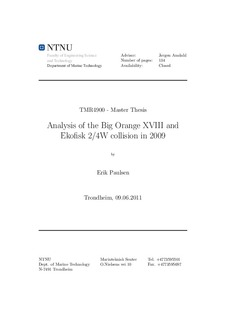| dc.contributor.author | Paulsen, Erik | nb_NO |
| dc.date.accessioned | 2014-12-19T12:06:38Z | |
| dc.date.available | 2014-12-19T12:06:38Z | |
| dc.date.created | 2012-02-08 | nb_NO |
| dc.date.issued | 2011 | nb_NO |
| dc.identifier | 492788 | nb_NO |
| dc.identifier.uri | http://hdl.handle.net/11250/237962 | |
| dc.description.abstract | This thesis consists of analyses and discussions regarding the collision between the offshore vessel Big Orange XVIII and Ekofisk 2/4W the 8th of June 2009. The collision caused the bow of Big Orange to deform three meters back from its original position. On the jacket installation, several braces were teared loose and the structure was pushed out of position. Although the installation endured large structural damages, it did not collapse. Based on the reported damage from NPD and the NORSOK design methods, the collision energy was estimated to be 58.7 MJ.
The collision analyses were performed by analyzing Big Orange and Ekofisk 2/4W in two separate uncoupled analyses. A model of Big Orange was made in Patran and analyzed in LS-DYNA. The first model of Big Orange had a 450mm mesh, but was refined to a 200mm mesh. The model of Ekofisk 2/4W was made and analyzed in USFOS.
The results from LS-DYNA were implemented as non-linear springs in the collision model in USFOS. Technical specifications regarding the vessel were provided by Ulstein Hatlø. Damage reports and structural arrangements regarding Ekofisk 2/4W were provided by Conoco Philips.
The model of 2/4W was analyzed in several conditions:
Pushover analyses in undamaged and damaged conditionStatic and dynamic ship collision analysisCollapse analysis
The pushover analyses were mainly performed to verify that the model behaved as to be expected for this type of structure, and that it could be used for ship impact analysis.
The static and dynamic ship collision analyses in USFOS had the non-linear springs from LS-DYNA implemented at the collision points to simulate the deformation of the bow in the ongoing collision. Two different dynamic collision models were tested. One model was unsupported, while one model had supports form the north and south bridges. The first collapse analyses were carried out by increasing the collision energy. This was done by increasing the vessel mass or velocity. The last collapse analyses were performed by changing the collision characteristics.
The deformation pattern for the unsupported model was similar to the reported damage both in response and in dissipated energy. Both the static and dynamic analyses dissipated the same collision energy that was estimated following the NORSOK methods. The structure had severe deformations when the collision energy was increased by 10%. The vessel speed would have been 5.019m/s with this energy increase.
The results obtained from the dynamic analysis were not so similar to the recommended design curves in NORSOK, but gave lower forces for displacements. They were however similar to the results Amdahl and Johansen obtained from simulations in 2002. Using LS-DYNA, they obtained load-deformation characteristics for collisions between a ship bow, and vertical leg columns and oblique braces. Improvements proposed to NORSOK could be to update the design curves for collisions with jacket legs and columns of similar diameters. The values for these collisions are the same as for large diameter columns, and are overly conservative if used for smaller diameters.
Because the non-linear springs in USFOS were based on mass and velocity from the actual event, the results from the collapse analysis may deviate from the actual response. To address this problem, the LS-DYNA collision model could be improved to check the results. | nb_NO |
| dc.language | eng | nb_NO |
| dc.publisher | Norges teknisk-naturvitenskapelige universitet, Fakultet for ingeniørvitenskap og teknologi, Institutt for marin teknikk | nb_NO |
| dc.title | Analysis of the Big Orange XVIII and Ekofisk 2/4-W collision in 2009 | nb_NO |
| dc.title.alternative | Analyse av kollisjonen mellom Big Orange XVIII og Ekofisk 2/4-W i 2009 | nb_NO |
| dc.type | Master thesis | nb_NO |
| dc.contributor.department | Norges teknisk-naturvitenskapelige universitet, Fakultet for ingeniørvitenskap og teknologi, Institutt for marin teknikk | nb_NO |
